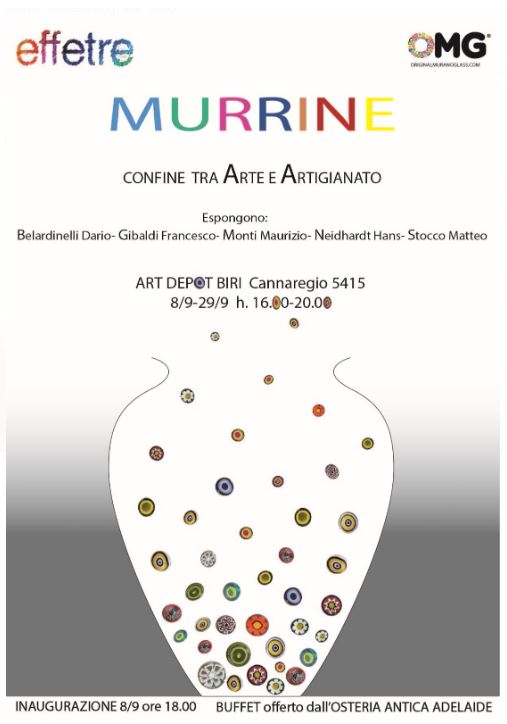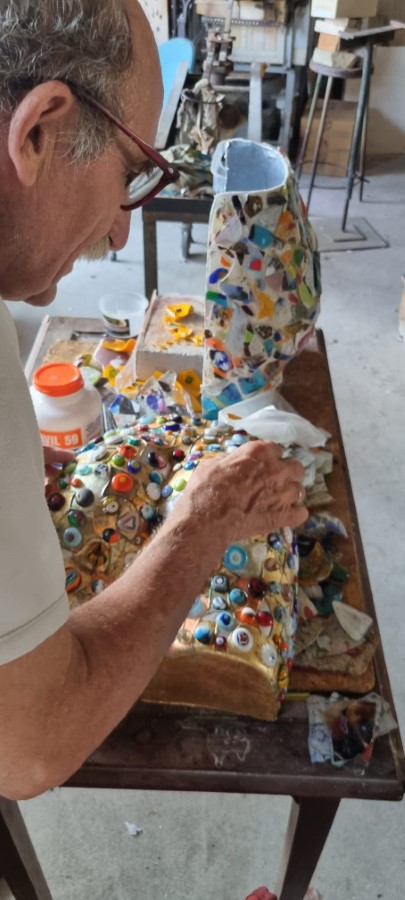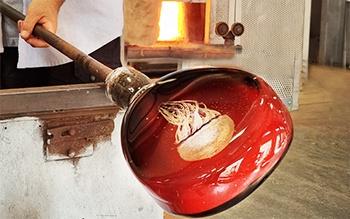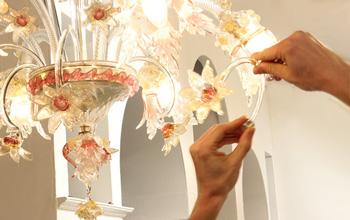The exhibition is held from 08.09 to 28.09.2023, from 4 to 8 pm, in ART DEBOIT Biri Cannaregio 5415, Venice.
MURRINE. Border between Art and Craftsmanship
«The creations of our hands [...] like the works of nature, are united by a few basic ideas whose simplest expressions are certain original forms and types [from whose development e
fusion still gives rise today] an infinite quantity of variations»
G. Semper, Prolegomena, in Der Stil in den technischen und tektonischen Künsten, oder Practische Aesthetik, Frankfurt a. M., 1860

This exhibition aims to be a reflection on the state of the art of the relationship between craftsmanship and the world of technology and machines that surrounds us.
They say: “In the future, machines will do everything!” . A legend, a fairy tale, a lie that has only one goal: to transform ourselves into consumers guided like automatons by the advertising that reaches us from the mobile phone. As Marshall McLuhan said in the 1960s, “We become what we see. Let's give shapes our tools and then our tools shape us”.
We are on this general theme of the relationship between technology and the modern and contemporary world spent great philosophers of the twentieth century and the central evidence of their reflections is that the world Western, in particular, has transformed technique from a tool for a purpose to an end in itself. This Copernican revolution brought about many changes in our way of life, in the relationship between individuals and between individuals and institutions, and also, deeply, in the economy.
Today we are in the midst of a great social and economic transformation, as everyone points out,
but every major transformation brings with it a collective and individual price to pay (just think
to the impoverishment of the lower classes at the time of the industrial revolution, for example) of which again
we don't know the contours.
In this troubled passage there is the risk of throwing away even the good things of the past. Work, the economic dimension of doing, has for some time put what work was into conflict artisanal – understood as the profession of “knowing how to make” beautiful things and useful things that once they moved not only an important piece of the economy, but also passions, falling in love for objects made well, the desire to own things that would live with us in our home and, therefore, our life - with the "progress" and the "utility" of things by attacking the times and costs of the way to produce.
If once applied arts and art were two contiguous worlds (hopping come to mind Toulouse Lautrec with his "manifestos", Carlo Scarpa with "his" artisans of glass, iron, wood, Edoardo Gellner, architect and craftsman in his own way, son of a decorator, the tables of Klimt, born to decorate environments…) today a furrow has opened up between them that is perhaps unbridgeable.
This exhibition is therefore also a denunciation, a scream!
A scream like Munch's, desperate and inconsolable.
A howl like Ginsberg's in the sixties, against the establishment, against things like that how they are about to convince you that you are the center of the world and not “they”.
A scream after the Covid storm, which was supposed to change everything with its tragedy and instead hasn't nothing changed, if not for the worse.
The promises of a bright future turned out to be fairy tales and empty words. As soon as the world recovered Inflation started in motion to which war was added.
This condition we find ourselves in reminds me of the story of the frog that is put on fire in the pot with cold water it doesn't run away and a little at a time it ends up boiled.
Some of these promises - but this is not new in the "physiology" of governments - declared commitments to intervene on the energy market, promises that then fell on deaf ears. Does the price of gas force us to close the ovens? As soon as it starts to drop, with a thousand sacrifices we get back to work and this seems to be enough for us.
It seems to me that a vision is missing, a new horizon to be built to change the conditions of the context, while always remaining faithful to ourselves and to our world.
Venice overrun by tourists? But there are many shops that remain closed and above all they are very few new artisan firms.
How to react ?
Inflating the chest with the famous 1000 years of history is not enough to rewrite our destiny. A comparison on a par with today's world dominated by robots, computers, Amazon is impossible.
 We must make the comparison with ourselves and check if our work still makes sense. If we artisans we no longer serve, if we are useless it is good that we close and do something else.
We must make the comparison with ourselves and check if our work still makes sense. If we artisans we no longer serve, if we are useless it is good that we close and do something else.
But if the basis of the relationship between man and the world is still "doing", then it is clear that we remain central. Craftsmanship is a privileged basis for being there and moving in reality. We represent a world of values that no machine can replace.
It is clear that there is a gigantic difference between a stonemason and Michelangelo, but it is just as much clear that between the two there is also a deep bond which is that of doing. Differently, in the field of art we have increasingly moved away from matter and rules, coming to conceive art today so-called conceptual that does not need anything: the exhibition of the idea itself is enough.
Applied art is considered a minor, second-class art.
And perhaps it is for this irreconcilable separateness and in the wake of a pale and ambiguous emancipation of art that decades ago the space for applied arts and glass was eliminated from the Biennale Murano.
And here we come to the second theme of this exhibition: the refusal to accept fences that are only useful for dividing.
They destroyed the culture of work, starting with the unification of middle schools: one school
one size fits all at a lower level and canceling professional schools.
And so on for decades in the separation between theory and practice, between school and work, up to the scandalous Gelmini law which in 2009 abolished the "art institutes" to transform them into high schools artistic, a very serious blow to the culture of doing with the deception of opening the world of art to young people: much easier, more fun and rewarding to go to school to become an artist than to qualified technicians, workers, craftsmen.
In this way a gap has been created between art itself and artistic craftsmanship. They have become two worlds that do not speak to each other. On the contrary, we think that borders should be understood as places meeting between different realities each with its own dignity and value.
And one of the reasons that inspired this exhibition is precisely to recover this relationship crossing ways, experiences, aspirations that converge towards the reaffirmation of value profound and sharing of the craftsman's doing.
From these considerations we are now looking for a glimmer of light.
DOING is medicine, the answer to the degradation we are experiencing, and the MAKING is craftsman!
KNOW,
DO, REDO, IMPROVE QUALITY,
HAVE MEASUREMENT, PRECISION, MEMORY, CONSTANCE,
COMPARE DAILY WITH THE RULES OF THE ART
These are the bricks with which the knowledge and the artisan culture are built, to create PROPERLY MADE OBJECTS!
Like the glass musical instruments that open this exhibition in a performance that combines music and glass.Hans Neidhardt
Venezia, settembre 2023
GALLERIA FOTOGRAFICA DELL'EVENTO PRESTO ONLINE












